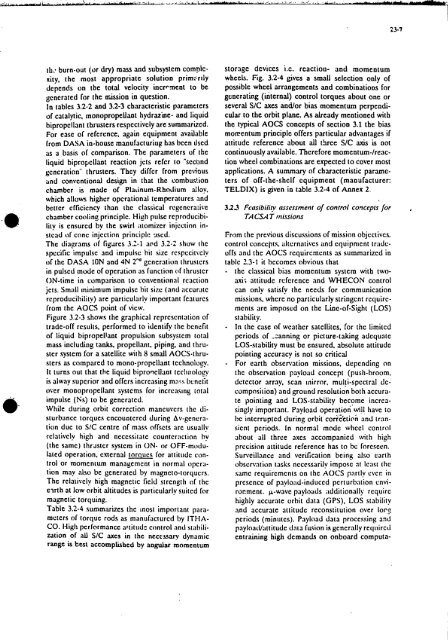0 - FTP Directory Listing - Nato
0 - FTP Directory Listing - Nato
0 - FTP Directory Listing - Nato
You also want an ePaper? Increase the reach of your titles
YUMPU automatically turns print PDFs into web optimized ePapers that Google loves.
th: burn-our (or dry) mm and subsystcm complc-<br />
xity, the most appropriate solution prim;:rily<br />
dcpcnds on thc total velocity incrrment to be<br />
gcncratcd for the &ion in question.<br />
In tablcs 3.2-2 and 3.2-3 characteristic parameters<br />
of catalytic, monopropellant hydrakc- and liquid<br />
bipropcllant thrusters respcctivcly arc summarizcd.<br />
For casc of rcfcrcnce. again equipment available<br />
from DASA in-house manufacturiug has bccn dscd<br />
as a basis of comparison. The parameters of the<br />
liquid bipropcUant rcaction jcts rcfcr IO "sccbnd<br />
ycncration" thrusters. Thcy diffcr from prcviious<br />
snd convcntional design in that thc combustion<br />
chambcr is made of Platinum-Rhodium dloy,<br />
which allows highcr opcrational tempcraturcs and<br />
bettcr cfficicncy than thc classical rcgcncrarivc<br />
chamber cooling principlc. High pulsc rcproducibi-<br />
litv is cnsurcd by the swirl iitomizcr injection in-<br />
stcad of cnnc injcction principlc xed.<br />
The diagrams of fiy;lrcs 3.2-1 and 3.2-2 show thc<br />
spccific impulse and impulse hit sizc rcspccitvclv<br />
of thc DASA ION and 4N 2"' gcncration thrustcrs<br />
in pulscd modc of opcration as function of thrustcr<br />
ON-time in cornpanson to convcntional rcaction<br />
jcts. Smilll minimum impulsc bit six (and ;iccurim<br />
rcproducibilitv) are particularlv important fcaturcs<br />
from thc AOCS point of vic~.<br />
Figure 3.2-3 shows the graphicai rcprcscntation of<br />
tradc-off rcsults, performed to idcntify thc bcncfit<br />
of liquid bipropellant propulsion subsystcm total<br />
mass including tanks. propellant. piping, and thru-<br />
stcr systcm for a satcllitc with 8 small AOCS-thru-<br />
sters as compared to mono-propellant tcchnoloq.<br />
It turns out that thc liquid biprooctlant tccli~iolog<br />
is alway supcrior and offcrs incrcasing m m bcnctit<br />
ovcr monopropellant systcms for incrcasing total<br />
impulse (Ss) to be gcncratcd.<br />
While during orbit corrcction mancuvcrs thc di-<br />
sturbancc torqucs cncountcrcd during AV-genera-<br />
tion duc to SIC ccntrc of mass offscts arc usually<br />
rclativcly high and ncccssitatc countcr;iction by<br />
(thc samc) IhrJstcr systcm in ON- or OFF-modu-<br />
latcd operation. cacrnal torqucs for attitudc con-<br />
trol or momentum manayemcnt in normal opcra-<br />
tion may also be gcncratcd by magcto-torquers.<br />
Thc rclativcly high magnctic ficld strcngth of thc<br />
ewth at low orbit altitudes is particularlv suitcd for<br />
magnetic torquing.<br />
Table 3.2-4 summarizes the most important para-<br />
metcis of torquc rods as manufacturcd by ITHA-<br />
CO. I-iigh pcrformancc attitude control anti stabili-<br />
zlltion of all SIC axes in the neccssary dynamic<br />
range is bat accomplishcd by angular momentum<br />
storsgc deviccs i.c. rcaction- and momentum<br />
wheels. Fig. 3.2-4 givcs a small selcction only of<br />
possible wheel arrangements and combinations for<br />
gcnerathg (idternid) control torques about one or<br />
several S/C 3x6 andlor bias momentum perpendi-<br />
cular to the orbit plane. As already mentioned with<br />
the typical AOCS concepts of section 3.1 the bias<br />
momentum principlc offcrs particular advantagcs if<br />
attitudc reference about all thce S/C ruciS is not<br />
continuously available. Therefore momcntum-/rex-<br />
tion whccl combinations arc expectcd to cover most<br />
applications. A summary of characteristic paramc-<br />
tcrs of off-the-shclf cquipmcnt (manufacturer:<br />
TELDIX) is given in tablc 3.2-4 of Annex 2.<br />
23-1<br />
323 Fcusibilify assessment of control co..tcepts for ,<br />
TACSA 7 missions<br />
From thc prcdous discussions of mission objcctivcs.<br />
control concepts, altcrnativcs and cquiprncnt trade-<br />
offs and thc AOCS rcquircmcnts as summarized in<br />
tablc 1.3-1 it becomes obvious that<br />
- thc classical bias momentum systcm with two-<br />
rvd.; attitudc rcfcrcnce and WHECON control<br />
can only satisfy thc nccds for communication<br />
missions. whcrc no particularly stringcnt rcquirc-<br />
mcnts arc imposcd on thc Linc-of-Sight (LOS)<br />
stability.<br />
- In thc case of wcathcr satcllitcs, for thc limitcd<br />
periods of ..:arming or picture-taking adcquntc<br />
LOS-stability must bc eacurcd. absolute attitudc<br />
pointing accuracy is not so critical<br />
- For carth obscntation missions. depcnding on<br />
thc obscrvation payload concept (push-broom.<br />
dctcctor array, scan mirror, mul!i-spcctral dc-<br />
compnsiiion) and ground rcsolution both accura-<br />
te pointing and LOS-stability bccomc incrca-<br />
singly important. Payload operation'will have to<br />
he intcrruptcd during orbit coh?ction ;i'nd trnn-<br />
sicnt pcriods. In normal modc whccl control<br />
about 311 three axcs accompanied with high<br />
prccision altitude rcferencc has to bc forcsccn.<br />
Suntcillnncc and vcrification bciny also carth<br />
obscrvntion tasks ncccssarilv imposc at Icast the<br />
siunc rcquircmcnts on the AOCS pnrtlv cvcc in<br />
prcscncc of payload-induccd perturbation envi-<br />
rocmcnt. p-wavc payloads additionally rcquirc<br />
highly accuratc orbit data (GPS), LOS stability<br />
and accuratc attitudc rcconstitution ovcr lor:<br />
pcriods (minutcs). Payload data proccssing and<br />
payloadhttitudc data fusion is gcncrally rcquircd<br />
cotraining high dcmanh on onboard computa-

















